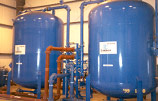|
|
Payson WQARF
Municipal Water Supply
Treatment


The Arizona Department of Environmental Quality (ADEQ) retained our staff to evaluate and select a groundwater treatment technology and design and construct the selected treatment system for a contaminated municipal well field. Contaminants of concern included the chlorinated solvents terachloroethylene (PCE), trichloroethylene (TCE), 1,2-dichloroethane (1,2-DCA), and cis-1,2-dichloroethene (cis-1,2-DCE) which came from a defunct dry cleaners that disposed of spent cleaner solvents into a dry well. The affected wells were installed by the Town of Payson to meet a projected water shortage, but the well water was found to be contaminated and could not be used without treatment.
The project was funded by the Arizona Water Quality Revolving Fund (WQARF) that provides money for site cleanup. The Payson WQARF site was one of the first major cleanups to be conducted under the program and served as a model for future sites. This was also the first design/build project of a treatment system for the ADEQ.

Our staff evaluated alternative treatment technologies for treatment efficiency, compatibility with drinking water treatment, operations and maintenance requirements, and life-cycle cost. Carbon adsorption was selected as the treatment method because it is proven and reliable and was less expensive than acceptable alternatives. Groundwater flow was modeled to assess contaminant capture and estimate groundwater extraction rates. The state-of-the-art system was designed to treat flows up to 1,300 gallons per minute at in influent PCE concentration of 2,000 μg/.

Our staff worked closely with ADEQ to define project requirements, to develop the technical scope, and construct and install the system. Our staff also responded to the needs of the Town of Payson to ensure that the requirements for the public water supply were met, including demand scheduling, operational requirements, and public relations. Because of projected water shortages in the Town of Payson a rapid schedule was placed on the project. Our staff completed the technologies evaluation in order to have a system on-line within 10 months. The treatment system was designed to be turned over to the town to operate. Therefore, the treatment system was designed to provide reliable operation with minimal operator commitment. System functions, including groundwater extraction, groundwater conveyance, system monitoring, alarm functions, and data management were controlled by a programmable logic controller (PLC) configured for remote system monitoring and operation through a human machine interface (HMI) with a dedicated on-site personal computer. Groundwater extraction pumps were controlled by variable frequency drive (VFD) controllers that allowed precise control of drawdown and well production. Treated groundwater is chlorinated with a sodium hypochlorite inline injection system as it is pumped to an on-site welded steel 100,000 gallons storage tanks. The treated and disinfected water is added to the distribution system through a duplex pump system that is flow controlled through a VFD. The conveyance piping for the all extraction wells was constructed of high density polyethylene SDR 11 BlueStripe NSF 61 certified pipe that was both butt fused and electro-fused for a zero leakage conveyance network. The system has had a 99-percent runtime with only downtime due to pre-filter and granular activated carbon change out.

|

